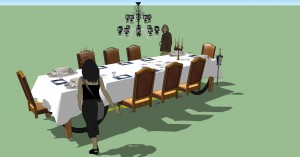For the past 4 years, I’ve been jealous of the kinetic sculptures at Burning Man. Duane Flatmo’s beautiful creations were the first to catch my eye. But soon I was noticing many other art bikes on the playa. I kept dreaming about building my own, but I couldn’t wrap my mind around how to get started. This past year I made an effort to walk around and meet some kinetic sculpture artists and find out how they built theirs. I looked at their drivetrains, suspensions, and wheels. There are so many aspects to think about in the design, but one has to start somewhere.
The first thing I needed was the art concept for mine. I mulled it over in the back of my mind for a few months. Finally I arrived at what I think is a winner: a banquet table art bike. The idea is that 8 people can sit around a large banquet table that is covered in a delicious feast: fruits, meats, cheese, goblets of beer and wine. The participants are naturally pedaling furiously under the table to propel the thing around the playa. During the day it could double as a mobile mad hatter’s tea party. I described my idea to Syyner Brent Houston and he whipped up a fantastic rendering for me.
Now it’s time to get started. I found a fantastic resource in Scotty C’s website. He gives a thorough explanation of how to build art bike wheels. I had met him at Burning Man and got his contact information. He even gave me a huge head start and delivered a chunk of 36′ diameter plastic culvert. Enough to cut up and make 7 wheels! That’ll give me enough for 4 wheels for my Banquet Bike and 3 more wheels for some sort of tricycle at some point in the future. Thanks so much, Scotty!
In describing this idea to my friends, I amassed a small group to help design and build the art bike. It’s much easier to build these things with some support from eager workers. Aaron Davis managed to salvage some aluminum car wheels (I think from a Toyota Prius) from some sort of junk yard. The wheels had bends in the rim so they wouldn’t hold air, and hence were useless for cars. But they will make nice and light hubs for our wheels.
I determined that our wheels should have 48 spokes each. They’ll have crossed patterns, so they can deal with the torque of pedaling. The front steering wheels technically don’t need such torque support, but it was easier to make my wheels uniform. I crunched some numbers to determine the length of the spokes and the hole spacing I’d need in the inner and outer wheels.
First we measured out the hole spacing in the aluminum wheels and punched them to keep the drill bit from walking.
I organized a work party to get started. We drew out our spacing on some tape and wrapped it around the aluminum wheels. It was straight forward to mark the wheel and give it a sharp rap with the punch.

Luckily aluminum is nice and soft.
Then it was a matter of drilling out all of the holes. 48 x 4 is 192 holes in the aluminum wheels. Of course, there is that many in the plastic as well. It goes a lot faster with multiple people taking turns and working in parallel.
Holden and Meagan make short work of the ABS spoke holes.
We then needed to repeat the process on the plastic culvert wheels. The spokes will go right between the corrugations. Washers will keep the spokes from pulling through. The plastic was much faster to drill, but it’s still a lot of holes.
For a little extra strength.
The next step was to start on the spokes. They’ll consist of 1/16″ aircraft cable with stopper ferrules on the end to keep it in the aluminum wheel. On the other end the cable will connect to eyebolts that will go through the plastic. We’ll be able to tighten the nylok nuts on the eyebolts to tighten the spokes as needed. I figured that we might as well weld the eyebolts all the way closed just in case they bend open up a bit over time and result in loosened spokes.
Lots of little parts to make the spokes.
We then started crimping together our spokes. We have 192 spokes to make, but you have to start with one at a time. It helps to have someone squeeze the crimper while the other person holds everything in the right place.  By this time we were a little exhausted and felt that we had made some great progress. But, we just had to assemble a proto-wheel with our first 16 completed spokes. This was also a good test of my math to determine the spoke length. We didn’t tighten anything down yet, but it definitely felt good to see the first wheel start to come together.
16 of 48 spokes. Well on our way!


